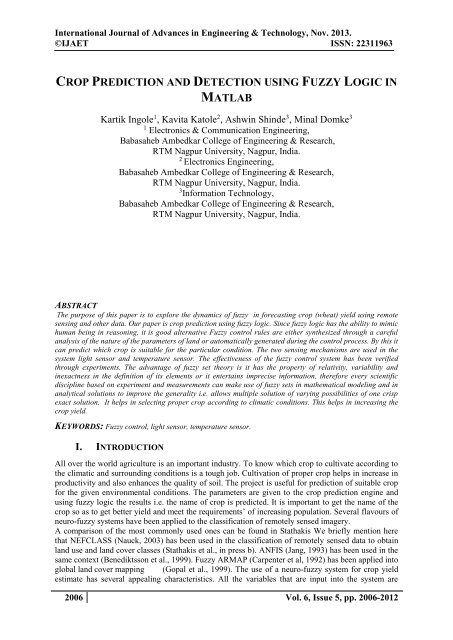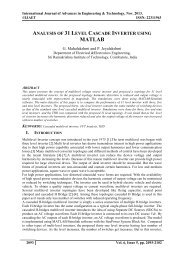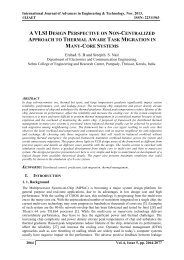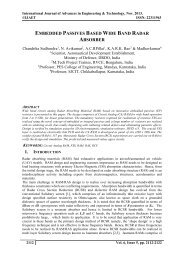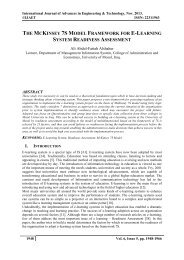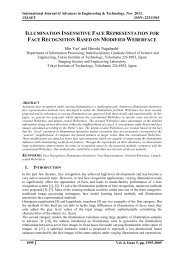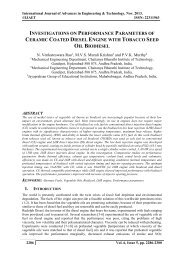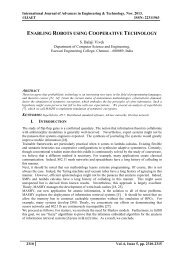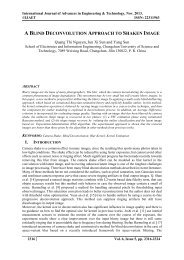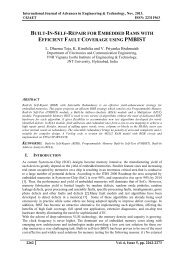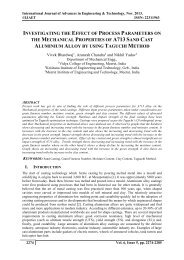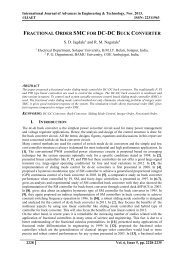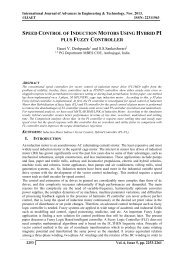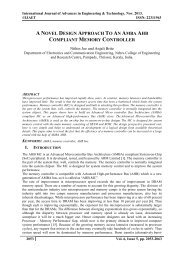CROP PREDICTION DETECTION FUZZY LOGIC MATLAB
The purpose of this paper is to explore the dynamics of fuzzy in forecasting crop (wheat) yield using remote sensing and other data. Our paper is crop prediction using fuzzy logic. Since fuzzy logic has the ability to mimic human being in reasoning, it is good alternative Fuzzy control rules are either synthesized through a careful analysis of the nature of the parameters of land or automatically generated during the control process. By this it can predict which crop is suitable for the particular condition. The two sensing mechanisms are used in the system light sensor and temperature sensor. The effectiveness of the fuzzy control system has been verified through experiments. The advantage of fuzzy set theory is it has the property of relativity, variability and inexactness in the definition of its elements or it entertains imprecise information, therefore every scientific discipline based on experiment and measurements can make use of fuzzy sets in mathematical modeling and in analytical solutions to improve the generality i.e. allows multiple solution of varying possibilities of one crisp exact solution. It helps in selecting proper crop according to climatic conditions. This helps in increasing the crop yield.
The purpose of this paper is to explore the dynamics of fuzzy in forecasting crop (wheat) yield using remote sensing and other data. Our paper is crop prediction using fuzzy logic. Since fuzzy logic has the ability to mimic human being in reasoning, it is good alternative Fuzzy control rules are either synthesized through a careful analysis of the nature of the parameters of land or automatically generated during the control process. By this it can predict which crop is suitable for the particular condition. The two sensing mechanisms are used in the system light sensor and temperature sensor. The effectiveness of the fuzzy control system has been verified through experiments. The advantage of fuzzy set theory is it has the property of relativity, variability and inexactness in the definition of its elements or it entertains imprecise information, therefore every scientific discipline based on experiment and measurements can make use of fuzzy sets in mathematical modeling and in analytical solutions to improve the generality i.e. allows multiple solution of varying possibilities of one crisp exact solution. It helps in selecting proper crop according to climatic conditions. This helps in increasing the crop yield.
You also want an ePaper? Increase the reach of your titles
YUMPU automatically turns print PDFs into web optimized ePapers that Google loves.
International Journal of Advances in Engineering & Technology, Nov. 2013.<br />
©IJAET ISSN: 22311963<br />
<strong>CROP</strong> <strong>PREDICTION</strong> AND <strong>DETECTION</strong> USING <strong>FUZZY</strong> <strong>LOGIC</strong> IN<br />
<strong>MATLAB</strong><br />
Kartik Ingole 1 , Kavita Katole 2 , Ashwin Shinde 3 , Minal Domke 3<br />
1<br />
Electronics & Communication Engineering,<br />
Babasaheb Ambedkar College of Engineering & Research,<br />
RTM Nagpur University, Nagpur, India.<br />
2<br />
Electronics Engineering,<br />
Babasaheb Ambedkar College of Engineering & Research,<br />
RTM Nagpur University, Nagpur, India.<br />
3 Information Technology,<br />
Babasaheb Ambedkar College of Engineering & Research,<br />
RTM Nagpur University, Nagpur, India.<br />
ABSTRACT<br />
The purpose of this paper is to explore the dynamics of fuzzy in forecasting crop (wheat) yield using remote<br />
sensing and other data. Our paper is crop prediction using fuzzy logic. Since fuzzy logic has the ability to mimic<br />
human being in reasoning, it is good alternative Fuzzy control rules are either synthesized through a careful<br />
analysis of the nature of the parameters of land or automatically generated during the control process. By this it<br />
can predict which crop is suitable for the particular condition. The two sensing mechanisms are used in the<br />
system light sensor and temperature sensor. The effectiveness of the fuzzy control system has been verified<br />
through experiments. The advantage of fuzzy set theory is it has the property of relativity, variability and<br />
inexactness in the definition of its elements or it entertains imprecise information, therefore every scientific<br />
discipline based on experiment and measurements can make use of fuzzy sets in mathematical modeling and in<br />
analytical solutions to improve the generality i.e. allows multiple solution of varying possibilities of one crisp<br />
exact solution. It helps in selecting proper crop according to climatic conditions. This helps in increasing the<br />
crop yield.<br />
KEYWORDS: Fuzzy control, light sensor, temperature sensor.<br />
I. INTRODUCTION<br />
All over the world agriculture is an important industry. To know which crop to cultivate according to<br />
the climatic and surrounding conditions is a tough job. Cultivation of proper crop helps in increase in<br />
productivity and also enhances the quality of soil. The project is useful for prediction of suitable crop<br />
for the given environmental conditions. The parameters are given to the crop prediction engine and<br />
using fuzzy logic the results i.e. the name of crop is predicted. It is important to get the name of the<br />
crop so as to get better yield and meet the requirements’ of increasing population. Several flavours of<br />
neuro-fuzzy systems have been applied to the classification of remotely sensed imagery.<br />
A comparison of the most commonly used ones can be found in Stathakis We briefly mention here<br />
that NEFCLASS (Nauck, 2003) has been used in the classification of remotely sensed data to obtain<br />
land use and land cover classes (Stathakis et al., in press b). ANFIS (Jang, 1993) has been used in the<br />
same context (Benediktsson et al., 1999). Fuzzy ARMAP (Carpenter et al, 1992) has been applied into<br />
global land cover mapping (Gopal et al., 1999). The use of a neuro-fuzzy system for crop yield<br />
estimate has several appealing characteristics. All the variables that are input into the system are<br />
2006 Vol. 6, Issue 5, pp. 2006-2012
International Journal of Advances in Engineering & Technology, Nov. 2013.<br />
©IJAET ISSN: 22311963<br />
associated with varying degrees of accuracy. The ambiguity steams from measurement error and<br />
generalisation. Using fuzzy sets instead of the actual values as inputs, we aim at shifting to the<br />
semantics of the data rather than its measure (Zadeh, 1999).<br />
II.<br />
<strong>CROP</strong> PRODUCTION TECHNOLOGIES<br />
The nutrient management technologies food production by the year 2020 needs to be increased by<br />
50 percent more than the present levels to satisfy the needs of around 8 billion people. Much of the<br />
increase would have to come from intensification of agricultural production. Importance of wise<br />
usage of water, nutrient management, and tillage in the agricultural sector for sustaining agricultural<br />
growth and slowing crop production depends on the successful implementation of the soil, water,<br />
down environmental degradation calls for urgent attention of researchers, planners, and policy<br />
makers. Crop models enable researchers to promptly speculate on the long-term consequences of<br />
changes in agricultural practices. In addition, cropping systems, under different conditions, are<br />
making it possible to identify the adaptations required to respond to changes. This book adopts an<br />
interdisciplinary approach and contributes to this new vision. Leading authors analyze topics related<br />
to crop production technologies. The efforts have been made to keep the language as simple as<br />
possible, keeping in mind the readers of different language origins. The emphasis has been on<br />
general descriptions<br />
Fig. 1.<br />
Effects of drought on farming areas<br />
III.<br />
EFFECTS OF DROUGHT ON FARM PRODUCTION AND LIVESTOCK<br />
HOLDINGS<br />
The main direct effects of drought on the farming sector are summarized in Figure 1. The most<br />
immediate consequence of drought is a fall in crop production, due to inadequate and poorly<br />
distributed rainfall. Farmers are faced with harvests that are too small to both feed their families and<br />
fulfill their other commitments. Livestock sales act as a buffer in times of hardship, farmers<br />
disinvesting in these assets to buy food. The first animals to be sold are usually those which make the<br />
least contribution to farm production, such as sheep and goats. However, as the period of droughtinduced<br />
food deficit lengthens, farmers will have to start selling transport and draft animals, such as<br />
oxen and donkeys, as well as breeding stock, which constitute the basis of the household's wealth. In<br />
the Ethiopian highlands, stock are usually disposed of in the following order: sheep and goats, then<br />
younger cattle, with horses, donkeys and work oxen being sold as a last resort (Wood, 1976), since the<br />
latter are essential for land preparation.6. Where crops have been badly affected by drought, pasture<br />
production is also likely to be reduced although output from natural pastures tends to be less<br />
2007 Vol. 6, Issue 5, pp. 2006-2012
International Journal of Advances in Engineering & Technology, Nov. 2013.<br />
©IJAET ISSN: 22311963<br />
vulnerable to drought than crop production. Low rainfall causes poor pasture growth and may also<br />
lead to a decline in fodder supplies from crop residues. Insufficient levels of fodder around the village<br />
lead to weigh less and increased deaths among stock, especially where immigrant herds put further<br />
pressure on limited local pastures. While the response of most pastoral groups to fodder shortage is to<br />
move themselves and their herds elsewhere, this is not an option so easily followed by livestockowning<br />
farmers. Typically, farmers own fewer animals and have less familiarity with regular<br />
transhumance than pastoralists, both of which act as constraints on migration. In addition, few farm<br />
households will have sufficient labor to both take their animals to other grazing areas and continue<br />
with necessary farming operations. These high losses were caused by pasture shortages exacerbated<br />
by herds from further north on their way to southern pastures, by the sedentary character of livestock<br />
holdings amongst farmers in this area and by the normal dependence of horses (and to some extent<br />
donkeys) on a daily grain ration to supplement natural grazing, a supplement which is no longer given<br />
because of poor harvests.<br />
IV.<br />
WAYS IN WHICH FARMERS CAN ACHIEVE <strong>CROP</strong> RECOVERY<br />
There are a number of options that farmers can pursue in order to restore levels of crop production<br />
and their holdings of draft animals. These include the sharing of animals between households, use of<br />
other stock for pulling the plough, hand cultivation of soils, hire of tractor services, changes in crop<br />
composition, purchase of fertilizer, supplementation of remaining stock, turning to income earned<br />
elsewhere or waiting for livestock holdings to re-grow. Each of these is discussed below.13. Sharing<br />
of animals between households may be possible where overall losses have been slight. Such animal<br />
loans are common in many farming systems in normal years, the loan of a plough team often being<br />
repaid with so many days of weeding labour. Alternatively, two households with a single ox each can<br />
arrange to take turns in using the oxen pair, as described by Gryseels and Anderson (1983) for<br />
Ethiopia. However, where oxen losses have been heavy, loans ill be less easy to arrange for those who<br />
have lost their draft animals and the cost of such loans are likely to increase.14. The use of other<br />
animals for draft may be possible where, for example, losses among horses and donkeys have been<br />
less severe than work oxen. The former will have a lower productivity but their availability will<br />
partially compensate for the loss of trained oxen. In extreme cases, even human labour has been used<br />
for pulling the plough, as in the period following the great rinderpest epidemic in Ethiopia in the<br />
1890s when an estimated 90% of the country's draft oxen were lost (Wolde Mariam, 1984). However,<br />
if work oxen holdings have been badly affected by drought it is likely that other stock will also have<br />
suffered high mortality or will have been sold to purchase food grains.15. Hand cultivation of part of<br />
the farmer's land may be possible in the absence of draft animals. However, this will be at the cost of<br />
lower crop output due both to the smaller area cultivated and the lower effectiveness of hand<br />
cultivation as opposed to plough techniques. Estimates of the land area whICh can be cultivated by<br />
hand vary from 10% to 50% of that which can be managed by a plough team, depending on the nature<br />
of soils and the time available for land preparation. Although uncommon where weeding is also done<br />
by plough, resort to hand techniques will lead to lower yields from the less optimal timing of this<br />
operation.16. The hire of tractor services is only open to a limited number of farmers with access to<br />
this service at reasonable cost. Hire of a tractor is usually more expensive than hire of a plough team<br />
for the same work and, in the case of Botswana, will normally require a cash outlay rather than<br />
repayment in labor or other services (Vie rich and Sheppard, 1979). For this reason, farmers who find<br />
themselves without work oxen will often also be without the funds to hire a tractor.17. A change in<br />
the composition of crops grown can reduce the farmer's tillage requirements. For example, in the case<br />
of Ethiopia, while teff needs a finely prepared seed bed, pulses can be sown on land that has received<br />
a more rudimentary tillage. Similarly, in Mali, millets can be sown on unplugged land whereas<br />
groundnuts require a prepared seedbed. The possibility of farmers moderating the impact of draft<br />
animal losses by switching to less tillage-intensive crops depends on their access to seed, their<br />
family's consumption needs and the prospects for marketing different crops, be made in the<br />
intervening years either to obtain food or to borrow draft power from elsewhere.18. Fertilizer<br />
purchases can moderate the fall in crop output arising from a decline in area cultivated by raising<br />
yields on the area actually farmed. The effectiveness of this option depends on crop response to<br />
fertilizer use and the relative costs of purchase, transport and application of fertilizer. Lack of cash at<br />
2008 Vol. 6, Issue 5, pp. 2006-2012
International Journal of Advances in Engineering & Technology, Nov. 2013.<br />
©IJAET ISSN: 22311963<br />
the farm level in the post-drought period prevents this option being widely pursued, in the absence of<br />
extensive government subsidies for the purchase and distribution of this input. Even then, farmers<br />
may still consider the use of fertilizer in poor seasons as involving too high a risk.19. Surviving draft<br />
animal may be given supplementary feed in order to increase their working capacity. This fodder<br />
could come from crop by-products or natural pasture and browse, both of whICh are likely to be in<br />
short supply following drought. Additional feed may be available from agro-industrial by-products,<br />
such as cotton seed, molasses and bran. Supplies of these products will be limited and their prices<br />
high where these are normally exported, (as in the case of many Sahelian countries) unless the<br />
government gives special priority to their local use.20. Incomes earned elsewhere can be used to buy<br />
replacement oxen. For example, migration earnings are a major source of cash incomes for many<br />
farming areas in southern Africa and the Sahel. Migration may be seasonal or involve the absence of a<br />
male household member for a number of years, during which time cash remittances are sent back to<br />
the farm sector for the purchase both of food and farm inputs. The ease with which these earnings can<br />
be used to finance the purchase of new work animals depends on the relative value of the remittance,<br />
the price of work oxen and the urgency of other calls upon cash income. In times of drought, urban<br />
labor markets are usually flooded with job-seekers leading to low real wage levels. For this reason,<br />
the size of migration earnings is likely to be low in the post-drought period and possibilities for<br />
acquiring the funds to purchase work oxen more limited than in normal times. It will also be harder<br />
for farmers to rebuild work oxen holdings where both the arable and the farm sector have been hit by<br />
drought.<br />
V. CIRCUIT DIAGRAM<br />
Fig 2.<br />
Hardware circuit assembling layout<br />
VI.<br />
WORKING<br />
Temperature sensor is connected to pin no.26 and light sensor is connected to pin no.27. IC 555 is a<br />
timer IC is connected to pin no 10. IC 555 works in two modes monostable and astable. Here we are<br />
using astable mode as in generates the frequency. This IC is a monolithic timing circuit that can<br />
generates accurate and highly stable time delay or oscillation. It is used to give delays to ADC.Select<br />
line i.e. pin 25 of ADC is connected to pin 13 of microcontroller. If 0 o is given temperature data is<br />
given to ADC and if 1 is given light data is given to ADC. Start of conversion pulse is given through<br />
pin no. 6 and 22. after completion of conversion end of conversion pulse get 1 and 8 bit data is<br />
transferred to microcontroller and displayed on LCD and PC through MAX 232 Power on reset circuit<br />
is connected to pin no.9. Power on reset circuit is essential because when the switch on the supply<br />
execution of program inside microcontroller starts from 00H MAX 232 is connected to pin no. 10 and<br />
11 of microcontroller. It converts signal from RS232 serial port to signal suitable for use in TTL<br />
compatible digital logIC circuit.<br />
2009 Vol. 6, Issue 5, pp. 2006-2012
International Journal of Advances in Engineering & Technology, Nov. 2013.<br />
©IJAET ISSN: 22311963<br />
VII.<br />
<strong>FUZZY</strong> <strong>LOGIC</strong> INTRODUCTION<br />
Fuzzy logic was initiated in 1965, by lot .A.Zadeh, professor for computer science at the University of<br />
California in Berkeley. Basically, fuzzy logic (FL) is a multivalve logic that allows intermediated<br />
values to be defined between conventional evaluations like true/false, yes/no, high/low etc. Notions<br />
like rather tall or very fast can be formulated mathematically and processed by computer, in order to<br />
apply a more humane like way of thinking in the programming of computers. Fuzzy systems are an<br />
alternative to traditional notions of set of membership and logic that has its origins in ancient Greek<br />
philosophy. The precision of mathematics owes its success in large part to the efforts of Aristotle and<br />
the philosophers who preceded him. In their efforts to devise a concise theory of logic, and later<br />
mathematics, the so- called “Laws of Thought” were posited. One of these, the “Law of the Excluded<br />
Middle”, states that every proposition must either be true or false. Even when Parmenides proposed<br />
the first version of this law (around 400 B.C.) there were strong and immediate objections: for<br />
example, Heraclitus proposed that things could be simultaneously true and not true. It was Plato who<br />
laid the foundation for what would become fuzzy logic, indicating that there was a third region<br />
(beyond True and False) where these opposites “tumbled about”. Others more modern philosophers<br />
echoed his sentiments , notably Hegel, Marx and Engels. But it was LukasiewICz who first proposed<br />
a systematic alternative to the bi-valued logic of Aristotle. Even in the present time some Greeks are<br />
still outstanding examples for fussiness and fuzziness,(note: the connection to logic got lost<br />
somewhere during the last 2millenniums).Fuzzy logic has emerged as a profitable tool for the<br />
controlling and steering of systems and complex industrial processes, as well as for household and<br />
entertainment electronics, as well as for other experts systems and applications like the classification<br />
of SAR data.<br />
Fig 3<br />
Fuzzy logic classification<br />
Fig 4 Fuzzy logic interpretation<br />
2010 Vol. 6, Issue 5, pp. 2006-2012
International Journal of Advances in Engineering & Technology, Nov. 2013.<br />
©IJAET ISSN: 22311963<br />
VIII.<br />
RESULTS<br />
Fig 5 Parameter of GUI for fuzzy output<br />
Fig 6 Fuzzy classification for various parameters<br />
Fig 7 Fuzzy Rule Base for Various Parameter<br />
IX.<br />
CONCLUSIONS<br />
Thus we have find out the Erosion model using spatial data on soils, land use and crop cover, weather<br />
and topological features was developed using GIS techniques. Finally, it would be very interesting to<br />
explore the knowledge learned by the fuzzy system by looking thoroughly into the rules created in the<br />
rule base. Perhaps this would provide an insight with respect to which are the most important factors<br />
in crop yield prediction using a data driven approach. We believe that parameters such as the<br />
number of fuzzy sets, the type of membership functions as well as the option to have different<br />
parameters per input, should receive more experimental effort.<br />
X. FUTURE SCOPE<br />
A possible way forward is to use a genetic algorithm to select the optimal values, that means we will<br />
implement all these parameters using genetic algorithm and will simulate this design using neural<br />
logic system. ANFIS has only one output node, the yield. In other words a single number is sought.<br />
2011 Vol. 6, Issue 5, pp. 2006-2012
International Journal of Advances in Engineering & Technology, Nov. 2013.<br />
©IJAET ISSN: 22311963<br />
An additional difficulty in predicting yield is that remote sensing data do not go long back in time.<br />
Hence any predicting effort is forced to use a very limited number of past years in order to construct a<br />
model to forecast future values. The system is trained by leaving one year out and using all the other<br />
data. We then evaluate the deviation of our estimate compared to the yield of the year that is left out.<br />
REFERENCES<br />
[1]. Moore, J.W.; Ramamoorthy, S. Heavy Metals in Natural Waters: Applied Monitoring and<br />
ImpactAssessment; Springer: New York, 1984; pp 182-204.<br />
[2]. Gorton, L.; Fiedler, U. Zinc Sensitive Polymeric Membrane Electrode. Anal. Chim. Acta.1977, 90,233-<br />
236.<br />
[3]. Linnersund, U.F.; Bhatti, K.M. Development of Polymeric Membranes for the Zinc-Ion Selective<br />
Electrodes. Anal. Chim. Acta.1979, 111, 57-70.<br />
[4]. Lebedeva, O.A.; Jansons, E. Cd and Zn-Selective Liquid Electrodes on the Basis of Quinoline-8-<br />
Carbodithioates. Latv. PSR Zinat. Akad. Vestis. Kim. Ser.1987, 4, 483-485.<br />
[5]. Kojima, R.; Kamata, S. Zinc Selective Membrane Electrode Using Tetrabutyl Thiuram<br />
DisulfideNeutral Carrier. Anal. Sci.1994, 10, 409-412.<br />
[6]. Rocheleaw, M.J.; Purdy, W.C. Investigation of Materials for Making a Carbon Support Zinc-Selective<br />
Electrode. Talanta.1990, 37, 307-311.<br />
[7]. Srivastava, S.K.; Vardhan, H.; Singh, M.; Rao, G.N.; Srivastava, S. A New Chelating Ion-<br />
Exchange Resin Based Sensor for Zinc Ions. Anal. Proc.1995, 32, 173-178.<br />
[8]. Obmetho, A.A.; Rakhmanko, E.M.; Lomako, V.L.; Starvobinets, G.L. Determination of Zinc in<br />
Alloys by a Ion-Selective Electrode. Zh. Anal. Khim.1988, 43, 444-452.<br />
[9]. Srivastava, S.K.; Gupta, V.K.; Jain, S. PVC-based 2,2,2-Cryptand Sensor for Zinc Ions. Anal. Chem.<br />
1996, 68, 1272-1275.<br />
[10]. Gupta, V.K.; Jain, A.K.; Singh, L.P.; Khurana, U. Zn2+ Sensor Based on Zn-bis(2,4,4-<br />
trimethylpentyl) dithiophosphinic acid Complex in PVC Matrix. Electrochim. Acta.1998, 43, 2047-<br />
2052.<br />
[11]. Gupta, V.K.; Chandra, S.; Chauhan, D.K.; Mangla, R. Membranes of 5,10,15,20-Tetrakis(4-<br />
Methoxyphenyl Porphyrinatocobalt (TMOPP-Co) (I) as MoO42- Selective Sensors. Sensors.2002, 2,<br />
164-174.<br />
AUTHORS<br />
Kartik Ingole has completed M Tech in communication From Priyadarshini College of<br />
Engineering and working as a Asst Prof in Dr. Babasaheb Ambedkar College of Engineering<br />
Nagpur. He has done his B.E. (Etrx) in 2009 from G.H. Raisoni College of Engineering<br />
Nagpur. His special field of interest includes Reconfigurable Computing, Wireless computing<br />
designing<br />
Minal Domke has completed M. Tech in (Computer Science Engg.)From Yashwantrao Chavan<br />
College of Engineering, Nagpur (YCCE),.She is working as a Lecturer in Information<br />
Technology Dept. of Dr. Babasaheb Ambedkar College of Engineering And Research<br />
of Meghe Group of Institutions from 10/06/2009<br />
Kavita Katole is presently working as Assistant Professor in Electronics Engineering<br />
Department of Dr. Babasaheb Ambedkar College of Engineering, Nagpur. She has done her<br />
M.Tech. (Electronics) in 2011 from G.H.Raisoni College of Engineering Nagpur. Her special<br />
field of interest includes Embedded System and signal processing.<br />
Ashwin A. Shinde did his Polytechnic diploma in IT from MSBTE. He received his B.E. degree<br />
in Information Technology from Rashtrasant Tukdoji Maharaj Nagpur University, Maharashtra,<br />
India in 2009 and completed his M.Tech in IT from LNCT institute, Bhopal, Rajiv Gandhi<br />
Prodyogiki Vishvavidyalaya University, Bhopal, India<br />
2012 Vol. 6, Issue 5, pp. 2006-2012


